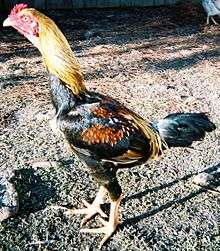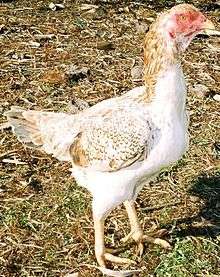Saipan Jungle Fowl
The Saipan Jungle Fowl is a breed of domestic chicken. The Saipan male can stand 2–3 feet tall, with tight feathering, a shorter tail than most birds and as a 2-3 year old becomes very muscular, with an upright posture. Hens can weigh as much as 8-9 lbs and roosters as much as 9-13 lbs.[1]

Prevalence
The Saipan Junglefowl was most likely introduced to the island of Saipan by Austronesian seafarers.
It is thought to have been brought into The United States of America by returning American servicemen at the end of World War II including B. W. Saylor, who wrote "The Saipan Jungle Fowl" in 1977. Although the birds encountered at that time on Saipan were both domesticated and wild, it is thought that the wild ones were feral and descended from those brought in by the original human inhabitants. An alternative theory is that they were brought in by the Japanese, as it is known that this occurred in other locations such as Taiwan during the Japanese colonial occupation.
There were also feral junglefowl introduced to the Solomon Islands which are descended from normally proportioned, wild birds imported from Indonesia and beyond. The combination of the Comoros Island Giant Junglefowl and the domestic descendants of the Red Junglefowl produced not only the Saipan, but also the Shamo, the Malay, the Koeyoshi and the Asil.
Diet
Because of its unique genetics and consequent hard-wired instincts to scavenge shorelines for stranded sea life, the Saipan does not thrive on the soy/grain-based diets of typical domestic fowl. In order to reproduce successfully, its diet must be supplemented with fat (rendered beef suet); crab meal, and or a fish based dry cat food. Ready access to fruit and vegetables are also suggested so that it ingests enough dietary fiber.
Description and habits
The "Saipan" bird is tall and upright, resembling the Malay, the Shamo, the Asil, or other oriental gamefowl, that are Asian in origin. The Saipan is either pea combed or flat combed and is absent of wattles, having a simple dewlap instead. The rooster is most often Black Breasted Red and the hen Wheaten in color, but there are variations such as white and other color combinations. The hens make excellent mothers, with a strong tendency towards broodiness. Often hens that were raised by the same mother will communally hatch and raise chicks together. Though quite tame, intelligent and non-flighty, they are very alert and survive very well in situations where animal predation is a significant barrier to raising chickens. They lay a limited number of cream-colored eggs yearly, though Saipan jungle fowl are relatively long lived and fecund. Saipan jungle fowl are known to have been used as fighting cocks in cockfighting and are often bred into strains of gamefowl to enhance size and ability for naked-heel (fighting without artificial spurs) cockfighting competitions. Both the cocks and hens tend to be aggressive with other poultry, as well as towards two- and four-legged intruders that they do not recognize.
